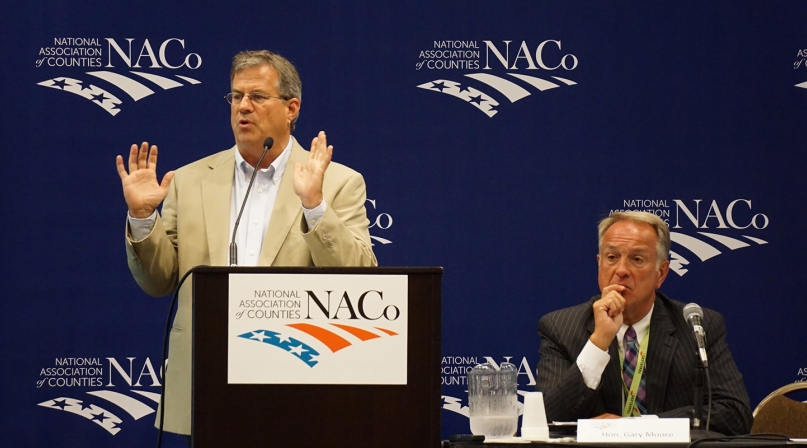Medical, criminal trends converge to create opioid and heroin epidemic

Counties fought opioid epidemic epidemic when others stayed quiet - @samquinones7
The opioid medication and heroin abuse epidemic has reached nearly every county in the United States, and as Sam Quinones tells it in Dreamland: The True Tale of America’s Opiate Epidemic, it was the convergence of two independent trends that crossed paths in the late 1990s.
Quinones spoke at a luncheon focused on the opioid drug epidemic July 22 during the Annual Conference, and earlier that day with County News.
The first trend was the rise of black tar heroin trafficking from Mexico starting in the ’80s. The increasingly corporatized trafficking operation spread eastward, without the accompanying violence characteristic of the urban heroin scene.
“They were delivering heroin like pizza franchises,” he told the luncheon audience. “They stressed customer service and went where there wasn’t any competition. And they offered a product that was more pure than what was coming from Burma or Turkey.”
The dealers were part of a non-centralized trafficking operation and all from a small town in western central Mexico, where a lack of economic mobility led many young men out of town, in hopes of making money to build houses for their families.
Drug cell operations reflected a professional approach that minimized risk by limiting the amount of heroin on each dealer, leaving police with little more the a light charge that would make prosecution, rather than deportation, more trouble than it would be worth. The cells stuck to rural areas and small towns, and did not get involved in turf wars that would draw the attention of law enforcement or political pressure to stop it.
“The cells didn’t just coexist, they shared inventory,” Quinones said.
On top of that, heroin coming from Mexico was cheaper, than drugs from Colombia, Turkey or Southern Asia. It was almost much more potent, too, because it wasn’t changing hands as much.
The drug cells spread to the eastern United States in the late 1990s, just as the market for heroin was building.
Meanwhile, a dramatic change in medical philosophy about using opioid painkillers for all manner of ills coincided with a pharmaceutical push to prescribe oxycodone, which is molecularly similar to morphine and heroin.
“A 101-word letter to the editor in the New England Journal of Medicine became the cornerstone, used as evidence to convince doctors that you could prescribe these pills for anything,” Quinones said.
“The new addicts were either following the doctor’s orders or getting into it recreationally. The pills take the tolerance to new heights, but then they can’t afford it so they switch to cheap heroin.
“It was a new kind of drug trafficking meets a new type of drug promotion.”
Pain became the fifth, unmeasurable, vital sign, and doctors, both well-meaning and corrupt, began prescribing opioid-based medications such as oxycodone for various conditions not limited to chronic pain.
Pharmaceutical companies were aggressive in marketing opioid-based painkillers, buttressed by the extrapolated finding that opioids were largely non-addictive when administered in a clinical setting. But now patients were being sent home with dozens of pills and little oversight.
“You get this almost complete buy-in from hospitals; medical schools begin teaching it as part of their curriculum,” he said. “All of this creates a massive opiate juggernaut that is an enormous amount of pills out there.”
Resources from Opioid Crisis Luncheon at the Annual Conference
- Esri Opioid Epidemic Story Map: Through this Story Map, you can view county level data on opioid prescriptions and much more interactive data on the opioid crisis.
- Presentations from Pharmacutical and Medical Leaders:
- County News Hot Topics: Counties Fight the Opioid Crisis
In Dreamland, Quinones wrote that prescribing a medication was more cost-effective for doctors, who wouldn’t be reimbursed by insurance companies for therapy that did the same thing but took longer.
“No one understood that this would lead to heroin, I think,” he said. “Most doctors want to do the right thing.”
Corrupt and troubled doctors found employment in shoddily-run pain management clinics, known as “pill mills” that required little diagnosis and had little oversight in most states.
Addicts and dealers could shop their prescriptions to different pharmacies without a prescription database to track drug use. Felons were not barred from operating these clinics, which became havens for doctors who couldn’t get work elsewhere.
Quinones described a city in southern Ohio as having deteriorated into a opioid-based economy, in which cash was replaced by different dosages of oxycodone.
But as the cost of painkillers increased as addicts’ tolerance increased, the market was primed for heroin to fill that need.
Throughout all of this, painkiller abuse and heroin use became a silent epidemic, in part because parents, who had come of age when heroin was an urban, “junkie drug,” were driven by stigma to hide the causes of their children’s deaths.
“They would say their son died of a heart attack, when it was really a heroin overdose,” Quinones said. “(It happened in) rural areas, suburban areas, small and mid-sized towns… Parents should have been the vanguard in getting the word out.”
Although the scourge has changed economies, taken lives and ruined others, Quinones and many of the people he talked to saw hope in the potential for a change in the criminal justice system, now that there is political pressure on the epidemic.
And he saw government, and county government, playing a crucial role in holding the line and advancing ways out of the problem.
“Government has been the line between us and total opiate mayhem for the last 20 years,” he said. “They were the ones fighting it when nobody wanted to talk about it, when no one cared… County government is the level of government that interacts most with the opiate epidemic: criminal justice, jails, county hospitals, coroners.
“If we’re not going to arrest our way out of this, we have to find more treatment beds,” he said. ”Jail is the place to make this difference. You have people detoxing and thinking clearly for the first time in years, and they realize they want to make a change in their lives. Right now, this is when we push them into a predatory, boring, non-productive system and instead we could treat and rehabilitate people who wind up in jail.”
Opt-in rehabilitation clinics in jails, he said, are the perfect chance to take idle inmates and give them a chance to heal. As he says, to not view jail as a parking lot.
“The infrastructure is there, because it’s more expensive to build a jail and put in the plumbing than to do the programming to make this possible,” he said.
“If that’s the legacy of this epidemic, we may actually thank heroin someday.”
Attachments
Related News

County Countdown – June 30, 2025
Every other week, NACo's County Countdown reviews top federal policy advocacy items with an eye towards counties and the intergovernmental partnership. This week features the Senate reconciliation debate, transparency on sanctuary designations and more.

Supreme Court’s Trump v. Casa, Inc. ruling limits use of nationwide injunctions: what this means for counties
On June 27, the U.S. Supreme Court issued a 6-3 decision in Trump v. Casa, Inc. limiting federal district court judges' ability to issue universal injunctions to prevent federal policies from going into effect nationwide.

County Leaders Visit Washington to Share Local Perspective on Budget Reconciliation
Elected officials from five states sound alarm about administrative and funding changes to SNAP and Medicaid.
